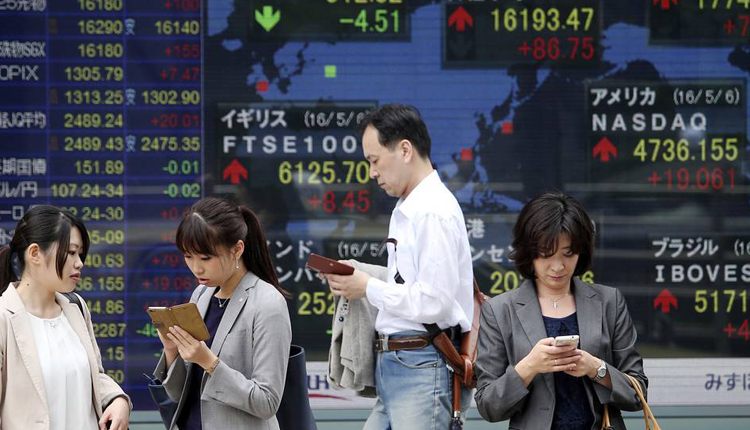Asia markets were mostly lower on Friday as major indexes see-sawed between gains and losses, with analysts questioning if a potential rebound will last.
In China, the Shanghai composite fell 0.19 percent to close at 2,598.85 while the Shenzhen composite slipped 0.169 percent to 1,290.62. Hong Kong’s Hang Seng index declined 0.92 percent in late-afternoon trade.
Japan’s Nikkei 225 gave up gains to slip 0.4 percent by the closing bell to 21,184.6 while the Topix index declined by 0.31 percent to 1,596.01.
South Korea’s Kospi dropped 1.75 percent to close at 2,027.15 while the Kosdaq index fell 3.46 percent to 663.07. Shares of major chipmaker SK Hynix saw a recovery from earlier losses, gaining 3.55 percent while Samsung Electronics was flat.
Australia’s ASX 200 closed near flat at 5,665.2, with the heavily weighted financial subindex up by 0.35 percent. Shares of the country’s so-called Big Four banks saw gains: ANZ advanced 0.44 percent, Commonwealth Bank gained 0.83 percent, the National Australia Bank was up 0.69 percent and Westpac rose 0.46 percent.
The moves in Asia followed overnight gains on Wall Street. Analysts remained skeptical about any potential bounce back in the region.
“We suspect that many investors are likely to be still licking their wounds after the recent sell-off so any rebound is likely to be muted barring a fresh catalyst,” analysts at Singapore’s OCBC Bank said in a morning note.
U.S. futures suggest lower open
U.S. futures pointed to a lower open stateside in the next session. During Asian hours, Dow Jones Industrial Average futures suggested a decline of more than 150 points at Friday’s open. S&P 500 and Nasdaq futures also pointed to losses.
“In light of disappointing revenue and outlook guidance from Alphabet (GOOG) and Amazon (AMZN) yesterday, it appears the U.S. futures market is continuing the after-hours selloff in those names, and tech stocks generally, that began after their quarterly reports,” Michael Cuggino, president and portfolio manager at Permanent Portfolio Family of Funds, told CNBC by email.
“This activity drives home the point that it remains an open question as to what degree the U.S. market, in which many names are already in correction mode, may fall further,” Cuggino said.
On Thursday, U.S. stocks saw a recovery from steep losses in the previous trading session. The Dow Jones Industrial Average jumped by 401.13 points to close at 24,984.55, snapping a three-day losing streak. The S&P 500 saw gains of 1.9 percent to close at 2,705.57. The gains sent the Dow and S&P 500 back into positive territory for 2018, but barely.
The Nasdaq Composite advanced by 2.95 percent to close at 7,318.34 .
One analyst questioned if the rebound in markets will last in the current environment.
“It is questionable how durable this rebound can be given that market participants remain nervous given concerns on trade war, global growth, geopolitics and corporate earnings,” Huani Zhu, an economist at Mizuho Bank, wrote in a morning note.
“Furthermore, higher input costs, resulting from an ongoing trade war and tightened monetary stance, is likely to harm corporate profit and this might further weigh on market sentiment,” she added.
ECB keeps rates on hold
In other news, The European Central Bank also left its benchmark interest rates unchanged on Thursday, something that one market observer said was not unexpected.
“As expected, the ECB left rates on hold and made no changes to its forward guidance, the Bank is still set to end its quantitative easing programme at the end of the year and rates are still expected to remain on hold ‘through the summer of 2019’,” Rodrigo Catril, a senior foreign exchange strategist at National Australia Bank, said in a morning note.
“The Euro was briefly boosted by Draghi’s comments, reaching an overnight high of 1.1432, but it seems that the market remains unconvinced on Draghi’s views that the risk to the outlook remain “broadly balanced,” he said, in reference to comments made by ECB President Mario Draghi.
The euro traded at $1.1372 Friday afternoon during Asian hours, after seeing a high above 1.14 yesterday.
Currencies and oil
The U.S. dollar index, which tracks the greenback against a basket of its peers, was at 96.620, climbing from an earlier low of 96.575.
The Japanese yen traded at 112.2 against the greenback after weakening yesterday from levels around 111.85. The Australian dollar was at $0.7039 after seeing a high above 0.709 yesterday.
Oil prices fell Friday with global benchmark Brent down 1.05 percent to $76.08 per barrel while U.S. crude futures declined by 1.19 percent to $66.53 per barrel.
